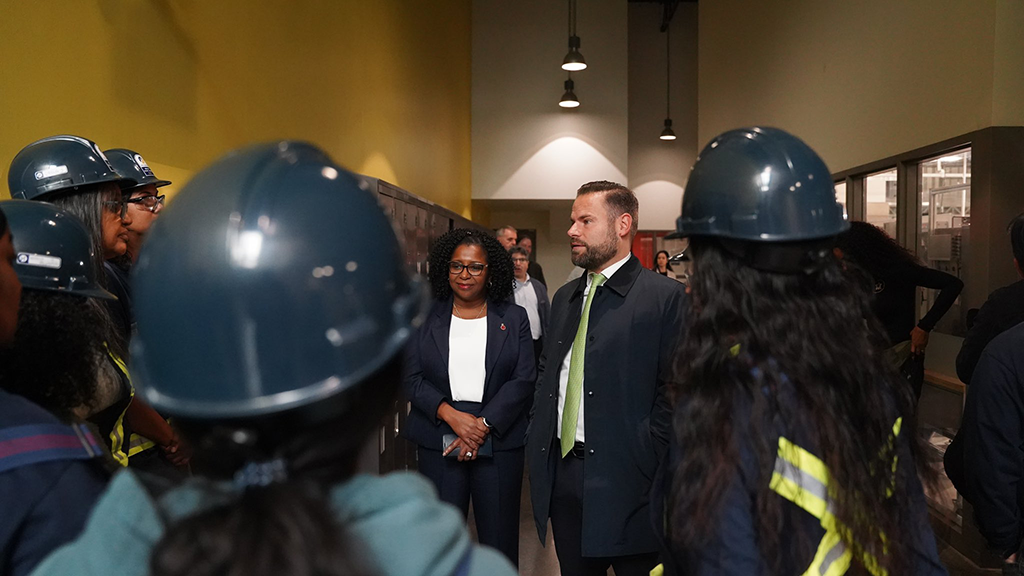Advocates for women in the trades say the Ontario government’s recently enacted Working for Workers Six legislation represents continued progress on the policy side in boosting inclusivity in the construction sector but argue troubling gaps remain.
Ontario Minister of Labour, Immigration, Training and Skills Development (MLITSD) David Piccini highlighted several measures intended to support women and families in the trades when he introduced the legislation in November.
Included were proposals for new parental leave to include adoption and surrogacy, create job-protected leave for serious illnesses, require properly fitting PPE for women in all trades sectors and further upgrade washroom sanitation on jobsites.
The Working for Workers Six Act received royal assent on Dec. 19.
“When we make the trades more inclusive, through properly fitting PPE, clean facilities and parental leave, we’re not just supporting women, we’re transforming the entire industry,” remarked
Natasha Ferguson, principal of Ethelfox Construct Group, in a statement.
Jennifer Khan, vice-president for inclusive and diversity with EllisDon, added, “By prioritizing safety inclusively, we not only encourage more women to join the sector but also clearly communicate they are not merely present in construction, they are essential and embraced.”
Both Karen Pullen, head of Ontario Building and Construction Tradeswomen, and Melissa Young, former CEO of Skilled Trades Ontario (STO), said the measures move the needle for women in the trades but Pullen said the industry must ensure implementation and Young suggested changing attitudes in the workplace is a long, slow process.
“We’re not there yet,” said Pullen. “We can’t pretend that we are. Absolutely, we’re moving in the right direction, but it’s a slow crawl.”
Pullen serves as a business rep for an IBEW local and hears complaints from women in the field. Sometimes women become uncomfortable with sexual advances, resolutions can’t be found and they have to move to other jobs, she said.
“What we need to happen, especially for women, is to have male allyship. Where your brother steps in and says, ‘You’re not going to treat her that way.’”
Additionally, she said, the culture in some construction workplaces still tends to discourage equity-seeking groups from speaking openly about problems.
Improved PPE is not only a diversity and inclusion issue, Pullen said, it’s also a safety concern. Women require different harnesses and restraints for working at heights because of their different physiology and women working with ill-fitting gloves risk getting them snagged in equipment.
Young, who in November left the top job at STO and returned to New Brunswick to run her own workforce consulting business and seek to represent the Conservatives as a candidate in the next federal election, said she was consulted by the Ontario government on the last several Working for Workers packages. It was a matter of the MLITSD bringing her a new set of initiatives and asking for her input, she said.
“I’ll say a lot of it is him (Piccini) going out and he’s very engaged.”
The government is making progress with its women in the trades initiatives, and employers are onside, Young said, but there’s a lag in uptake in the workforce.
“There’s a lot of people who have been in the trades a really long time, and change is really hard to swallow for some of them,” she said. “That’s where the biggest piece of work needs to be done, educating the workforce about inclusivity and not being a bystander.”
The new 16-week job-protected leave under the Employment Standards Act for adoptive parents and parents through surrogacy is intended to ensure they have adequate time to meet the demands of the adoption or surrogacy process and welcome their child into their new home.
It was enacted alongside a new 27-week long-term illness leave for employees unable to work due to a serious medical condition, such as cancer, multiple sclerosis or Crohn’s.
“There’s a lot more women getting into construction, and so it’s very important that they have these safety nets in place so that people feel they can take the time to be with their families, whether it be a new child coming into your home or major medical episodes,” said Pullen.











Recent Comments